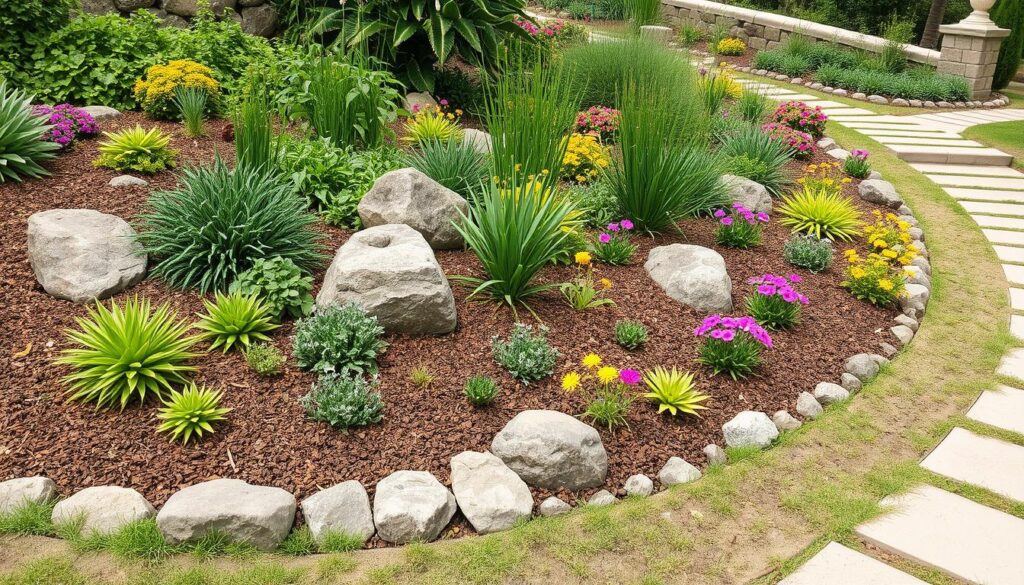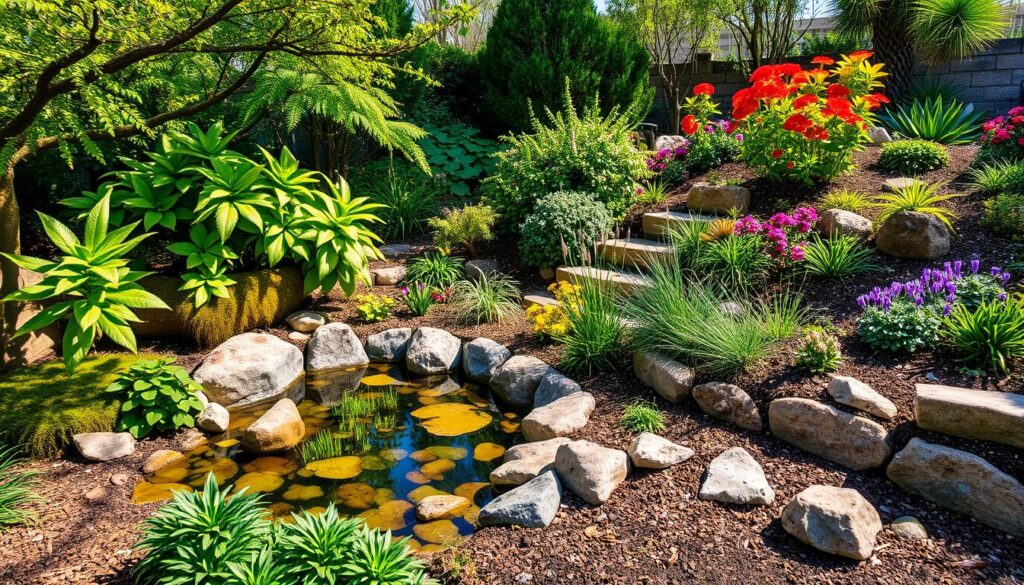Ever thought of making your garden a lush oasis using less water? With water becoming scarcer, saving water in gardens is key. By using green landscaping tips, you can make your garden beautiful and help the planet. This section shows how smart water use can benefit your garden and the environment.
Key Takeaways
- Optimizing water usage is crucial for sustainable gardening practices.
- Utilizing eco-friendly landscaping tips can contribute to lower water consumption.
- Implementing water-saving garden strategies benefits both gardeners and the environment.
- Adapting effective water management techniques leads to healthier plant growth.
- Conserving water in gardens reflects a commitment to responsible resource use.
Understanding the Importance of Water-Saving Strategies
Water is very important, and we need to save it. Saving water in gardening helps us use this resource wisely. It also makes gardening better for the planet.
Why Saving Water Matters
Every drop of water is crucial for healthy plants. Using water-saving techniques helps gardeners use less water. This saves money and helps the plants and the environment.
The Environmental Impact of Gardening
Old ways of gardening use too much water and pollute. We need to use water more wisely. This helps protect local water and makes gardens better for wildlife.
Assessing Your Garden’s Current Water Needs
Knowing how much water your garden needs is key to saving water. A water audit helps you see how much you’re using and where you can cut back. This info helps you pick the right plants and watering methods, saving water and keeping plants healthy.
Conducting a Water Audit
A water audit is a detailed check of your garden’s water use. Here’s how to do it:
- Keep a record of when and how much you water.
- Check the soil’s moisture with a meter or by hand.
- Look at your plants’ health. Sick plants might need more or less water.
- Measure the water your system uses with a rain gauge.
- See if your watering methods are efficient. Maybe drip irrigation is better.
After your audit, you’ll know how to make your garden use less water. You can choose plants and watering methods that save water and keep your garden looking great.
Selecting Native and Drought-Resistant Plants
Adding native and drought-resistant plants to your garden makes it look great and saves water. These plants fit well with local weather and soil, perfect for xeriscaping. By picking the right plants, you can make a beautiful garden that needs little water.
Benefits of Native Plants
Native plants have many benefits:
- Adaptation: They grow well in specific climates and soils, making them strong.
- Lower Maintenance: They need less care, like watering and fertilizing.
- Biodiversity: They help local wildlife, making ecosystems healthier.
- Water Efficiency: They use less water than other plants, fitting well with drought-tolerant gardens.
Recommended Drought-Resistant Species
Here are some drought-resistant plants that do well in different areas:
| Plant Name | Water Requirements | Ideal Regions |
|---|---|---|
| Agave | Very Low | Southwest, Mexico |
| Lavender | Low | California, Mediterranean |
| Bee Balm | Moderate | Eastern U.S., Midwest |
| Russian Sage | Low | Great Plains, Southwest |
| Perennial Sunflower | Moderate | Midwest, Northeast |
Using these plants in your garden is a smart choice for xeriscaping. It leads to beautiful, water-saving gardens.
Implementing Efficient Irrigation Systems
Efficient irrigation systems are key to saving water and keeping plants moist. Using drip irrigation and rainwater harvesting helps gardeners use water wisely. These practices cut down on waste and support green landscaping.
Drip Irrigation Explained
Drip irrigation sends water straight to plant roots. It cuts down on evaporation and runoff, saving water. The main parts are:
- Drip Emitters: These small devices release water slowly and consistently to the soil.
- Hoses: Special tubing carries water from the source to the emitters.
- Pressure Regulators: These ensure water flows at a controlled rate, preventing overwatering.
Drip irrigation makes watering plants efficient, saving water and keeping plants healthy.
How to Set Up a Rainwater Harvesting System
Collecting rainwater is a smart way to use natural resources. Here’s how to set up a rainwater harvesting system:
- Choose a suitable location for your rain barrel, typically near the downspout of your roof.
- Install a rain barrel with a secure lid to prevent contamination.
- Connect a downspout diverter to direct water into the barrel during rainfall.
- Ensure the barrel has a tap near the bottom for easy access to the harvested water.
This method provides a green irrigation source. It also cuts down on the need for city water, following eco-friendly landscaping tips.
| Feature | Drip Irrigation | Rainwater Harvesting |
|---|---|---|
| Water Source | Controlled from a water source | Natural rainfall |
| Efficiency | Highly efficient | Utilizes natural resources |
| Installation Complexity | Moderate | Simple |
| Cost | Higher initial setup | Lower setup cost |
By using these methods, gardeners can make their landscaping more eco-friendly. This ensures every drop of water is used wisely.
The Role of Mulching in Water Conservation
Mulching is key to saving water in your garden. It keeps the soil moist, stops weeds, and controls soil temperature. Using eco-friendly landscaping tips with mulching boosts your garden’s health and saves water.
Types of Mulch and Their Benefits
Knowing the different mulches helps gardeners pick the best one. Here are some common types:
- Organic Mulch: Made from natural stuff like bark, straw, or shredded leaves. It makes the soil better as it breaks down and keeps moisture in.
- Inorganic Mulch: Includes things like rubber or gravel. It doesn’t break down but keeps weeds away and holds moisture well.
- Living Mulch: Uses low-growing plants to cover the soil. It creates a healthy environment and improves soil quality.
How to Properly Apply Mulch
Applying mulch right is crucial for its effectiveness. Here’s how to do it:
- Make sure the soil is weed-free and clean before adding mulch.
- Put down a 2-4 inch layer of mulch around your plants, but not touching the stems.
- Water the mulch well after putting it down. This lets it settle and stick to the soil.
Choosing the Right Soil for Water Retention
Choosing the right soil is key for a water-efficient garden. The soil’s makeup affects how well it holds water. This is vital for gardens that use less water. Knowing what makes up the soil helps gardeners create the best conditions for plants and save water.
Understanding Soil Composition
Soil is made up of different parts, each affecting how it holds water. The main parts are:
- Sand: It drains well but doesn’t hold much water.
- Silt: It balances drainage and water retention.
- Clay: It holds water well but can cause drainage problems if too much.
- Organic Matter: It improves soil structure and helps it hold water better.
These parts work together to affect how well the soil holds water. Knowing this is important for gardeners who want to use water wisely.
Techniques to Improve Soil Quality
Improving soil quality helps it hold water better. Some good ways to do this are:
- Adding organic matter like compost or well-rotted manure to improve soil structure.
- Using soil amendments like peat moss or coconut coir to help it hold more moisture.
- Practicing no-till gardening to keep the soil intact and support good microbes.
- Testing the soil’s pH and nutrient levels to see what it needs to improve.

Using these methods to improve soil not only helps with water retention. It also supports sustainable gardening. Good soil management is the base of a water-efficient garden. It leads to gardens that thrive with less water.
Grouping Plants by Water Requirements
Grouping plants by their water needs is a smart way to keep your garden healthy. By placing plants with similar water needs together, you save water and help your garden grow. This method makes watering easier and helps plants not fight for water.
Using these methods makes your garden look great and is good for the planet. It shows how important it is to take care of our environment through gardening.
Companion Planting for Water Efficiency
Companion planting is a great way to make your plants healthier and use less water. Some plants help each other grow, keep pests away, and get stronger. Here are some good things about using companion planting:
- Improved soil health: Different plants’ roots help the soil stay moist and healthy.
- Pest control: Some plants keep pests away from other plants, so you don’t need to use chemicals.
- Increased biodiversity: More plants attract good insects, making your garden ecosystem balanced.
By using these ideas, gardeners can create stunning gardens that are also good for the planet. Even in areas with little water, gardens can flourish with careful planning.
Timing Your Watering Schedule
Choosing the right time to water your garden is key to saving water. Watering at the best times helps plants grow better. Early morning or late evening are the best times because the soil absorbs water better without losing it to heat.
Best Times to Water Your Garden
Knowing when to water is crucial for a healthy garden. Here are some tips:
- Water in the early morning, between 5 AM and 9 AM.
- Water in the late evening, from 7 PM to 9 PM, for cooler conditions.
- Don’t water during the hottest part of the day to avoid stress on plants.
Utilizing a Watering Calendar
A watering calendar can make watering easier and save water. It helps you keep track of when to water and adjust for weather changes. Here’s a simple weekly calendar:
| Day | Watering Time (Recommended) | Notes |
|---|---|---|
| Monday | 7 PM | Incorporate rainwater if applicable |
| Wednesday | 8 AM | Check soil moisture beforehand |
| Friday | 7 PM | Adjust frequency based on rainfall |
Creating Microclimates in Your Garden
Gardens have different spots that affect how plants grow and use resources. Knowing about microclimates is key for saving water. Microclimates are special areas in your garden with their own temperature, moisture, and light levels. These can be near trees, walls, or other features.
By changing these areas, you can make your plants healthier and use less water.
What Are Microclimates?
Microclimates are small climate spots that are different from the rest of the garden. They can be warmer, cooler, wetter, or drier. For example, spots under trees stay cooler and hold more moisture.
By knowing your garden’s spots, you can place plants where they’ll do best.
Techniques to Create Microclimates
Using certain methods can make your garden more efficient. Here are some ways:
- Planting Trees and Shrubs: Trees can shade and block wind, making areas cooler.
- Utilizing Walls and Fences: Plants against walls get heat and wind protection.
- Group Plants Strategically: Group plants with the same water needs to keep moisture better.
- Incorporating Stones and Pathways: Stones and paths absorb heat and release it at night, changing the area’s temperature.

These xeriscaping methods make your garden stronger. By making microclimates, you help your plants grow well and use less water.
Utilizing Ground Covers for Water Retention
Ground covers are a great choice for gardeners wanting to keep soil moist and use less water. They cover the soil, stopping water from evaporating. This helps plants stay healthy. Adding ground covers to your garden is good for the environment and saves water.
Benefits of Ground Covers
Ground covers have many benefits, including:
- Reduced Evaporation: A thick layer of ground cover keeps soil moist. This means plants have enough water.
- Weed Suppression: Ground covers block sunlight, stopping weeds from growing. This saves water and nutrients for plants.
- Soil Erosion Prevention: Ground cover roots hold the soil in place. This stops erosion and keeps topsoil from washing away.
- Increased Biodiversity: Different ground covers attract good insects and pollinators. This makes your garden healthier.
Recommended Ground Cover Options
Picking the right ground cover is key for keeping water in the soil. Here are some options that are good for the environment:
| Ground Cover | Water Needs | Additional Benefits |
|---|---|---|
| Creeping Thyme | Low | Attractive flowers and aromatic foliage |
| Pachysandra | Moderate | Shade tolerant and evergreen, creating year-round coverage |
| Ajuga (Bugleweed) | Low | Fast-growing with vibrant foliage and flowers |
| Sedum | Very Low | Ideal for sunny areas; drought-resistant |
Keeping Your Garden Free from Weeds
Weeds compete with your plants for water and nutrients. This makes weed management key in any water-efficient garden. Effective weeding techniques help your plants grow better and save water. Here are some tips for a weed-free garden.
Effective Weeding Techniques
Manual removal is a simple, eco-friendly way to control weeds. Pulling weeds by hand removes the root, stopping them from coming back. Mulch also helps by blocking weeds and keeping soil moist. Organic mulch like wood chips or straw also improves soil quality.
The Role of Weeds in Water Competition
Weeds take water away from your plants, making it hard for them to grow. Keeping your garden weed-free helps your plants get the water and nutrients they need. This is important for a successful, water-saving garden.
Monitoring and Adjusting Water Usage
Effective water management is key in sustainable gardening. By keeping an eye on and adjusting water use, gardeners can improve their irrigation. Tools like soil moisture meters and irrigation timers help understand how much water is needed. This prevents over-watering and helps plants grow well.
Tools for Tracking Water Usage
Adding technology to your gardening can make a big difference. Soil moisture meters give you instant soil moisture readings. Irrigation timers set watering schedules based on your garden’s needs. These tools help your garden get the right amount of water, saving resources and keeping plants healthy.
Evaluating and Tweaking Strategies
Gardening is a continuous learning journey. Regularly checking your water management plans is crucial for success. By watching how your plants do and adjusting your methods as needed, you can always get better. This approach not only fits with sustainable gardening but also makes your gardening more rewarding.
FAQ
What are some effective water-saving garden strategies?
To save water in your garden, use drip irrigation and pick plants that don’t need much water. Apply mulch to keep moisture in the soil. Group plants by their water needs. These steps help make your garden water-efficient.
Why is eco-friendly landscaping important?
Eco-friendly landscaping protects natural resources and reduces water waste. It also boosts biodiversity. By using green gardening solutions, you can have a beautiful, easy-to-care-for landscape.
How can I improve my soil for better water retention?
To improve soil for better water retention, add organic matter like compost. Use soil amendments to help it hold moisture. Knowing your soil type is crucial for low-water gardening.
What is xeriscaping, and how can it benefit my garden?
Xeriscaping uses drought-resistant plants and designs to save water. It also cuts down on garden work. It’s great for dry areas and is a sustainable choice.
How do I create microclimates in my garden?
Create microclimates by placing trees for shade and arranging plants for light. Use windbreaks to protect plants. These steps help your garden save water by giving plants the right conditions.
What are some tips for timing my garden watering schedule?
Water your garden in the early morning or late evening to reduce evaporation. Use a watering calendar to keep a regular schedule. This ensures your plants get enough water while saving water.
How can ground covers help with water retention?
Ground covers reduce evaporation and stop weeds. They cover the soil, making your garden more efficient. This helps low-water gardening methods work better.
What are the benefits of using native plants in my garden?
Native plants need less water and support local wildlife. They’re well-suited to local climates. Using them in your garden is good for the environment and saves water.
How do I monitor my garden’s water usage effectively?
Use tools like soil moisture meters and irrigation timers to track water use. Regular checks help you adjust your gardening to save more water. This aligns with conservation goals.


